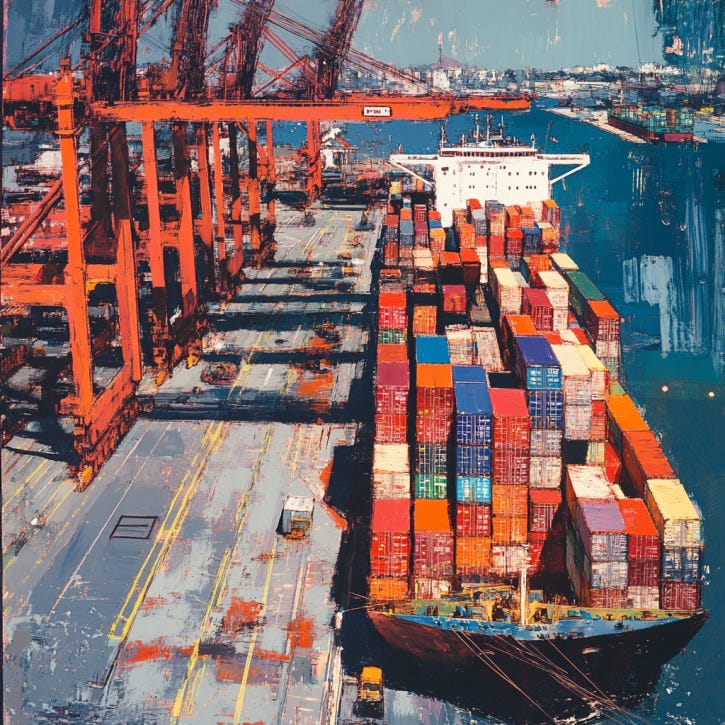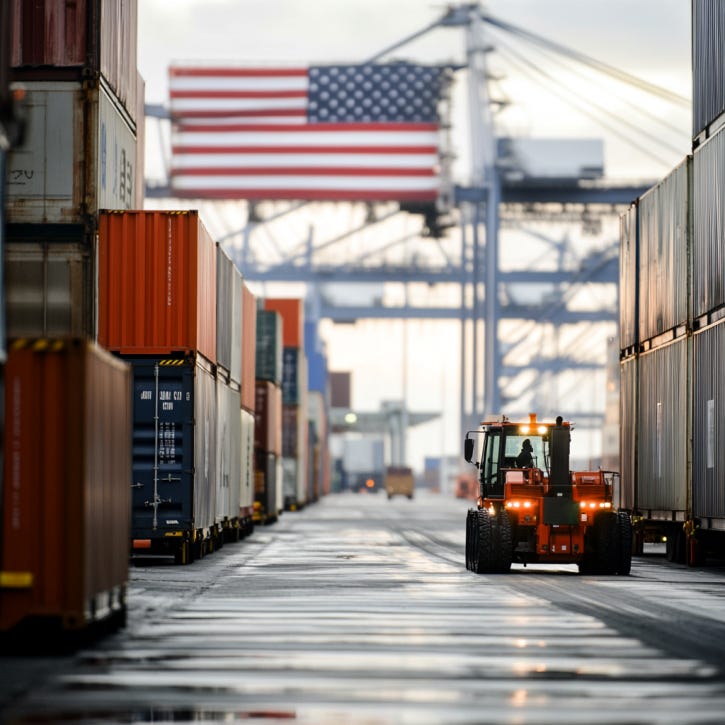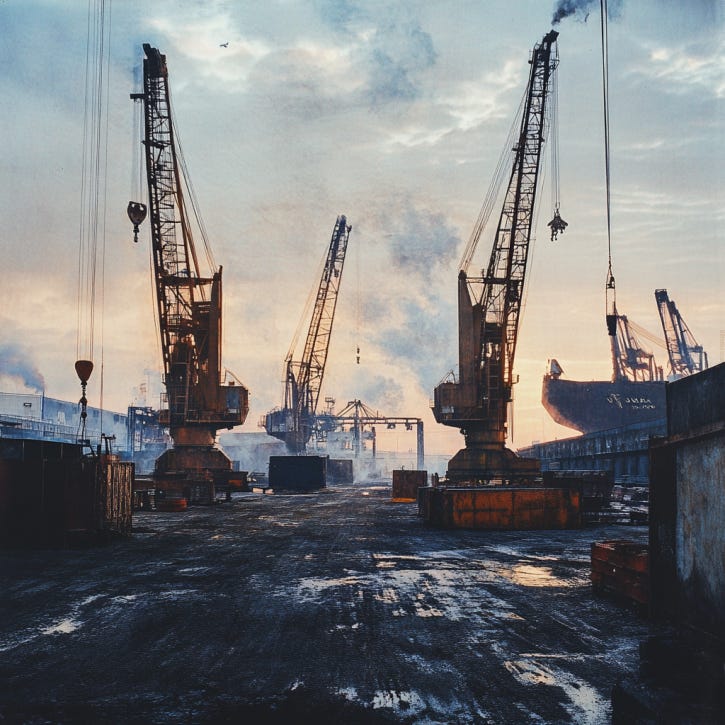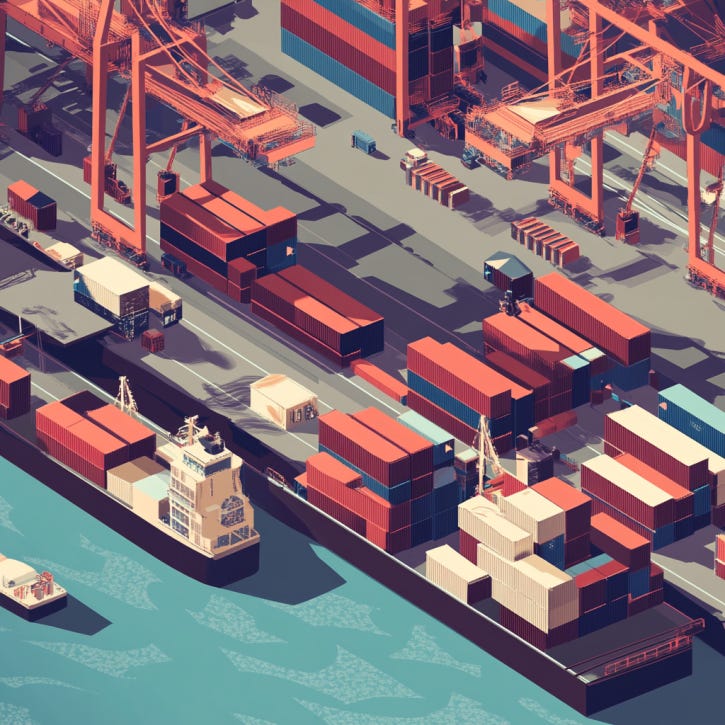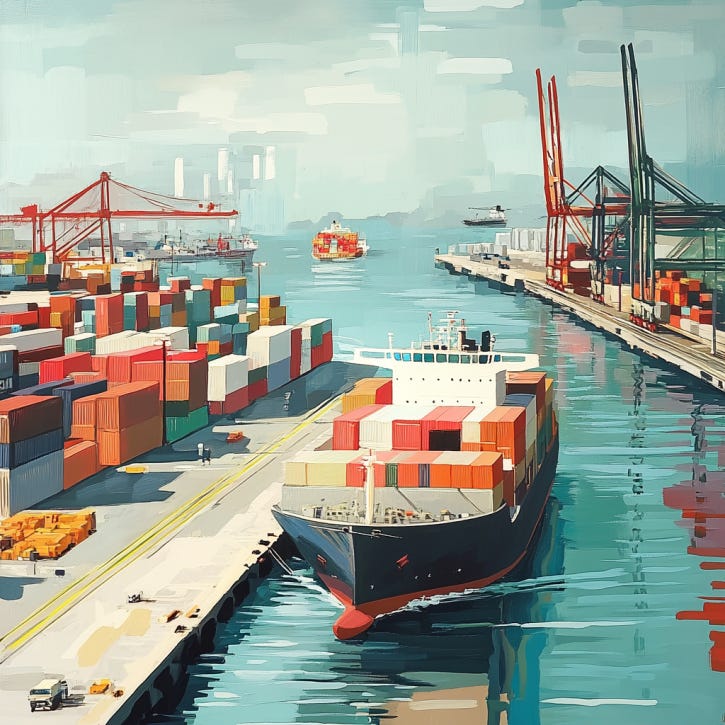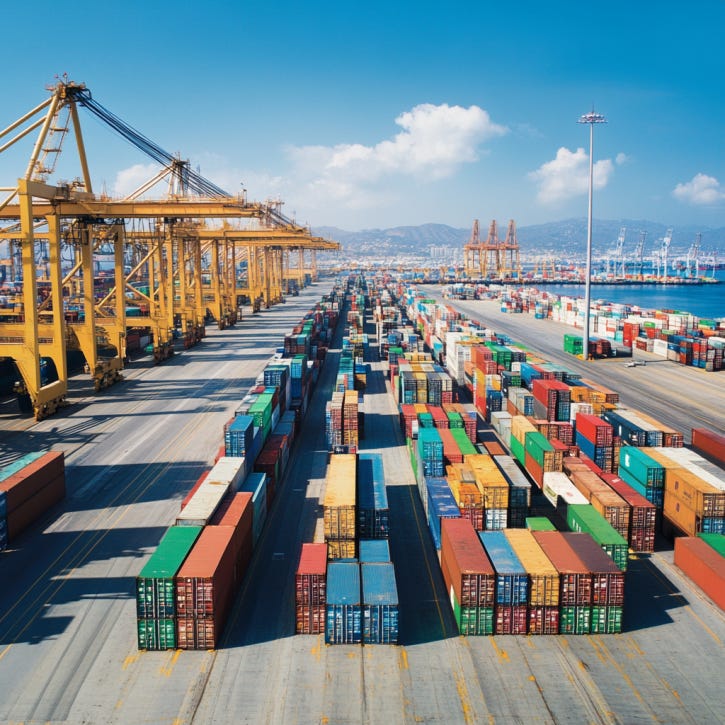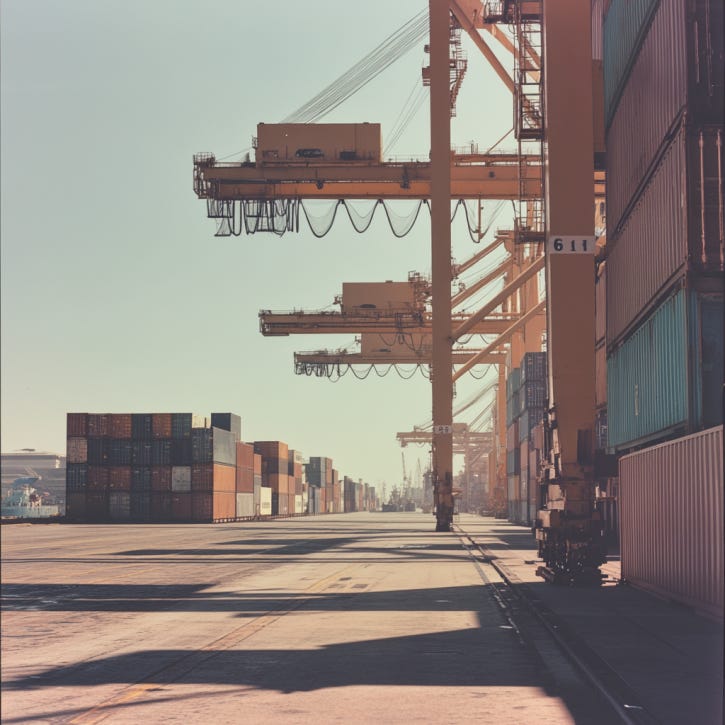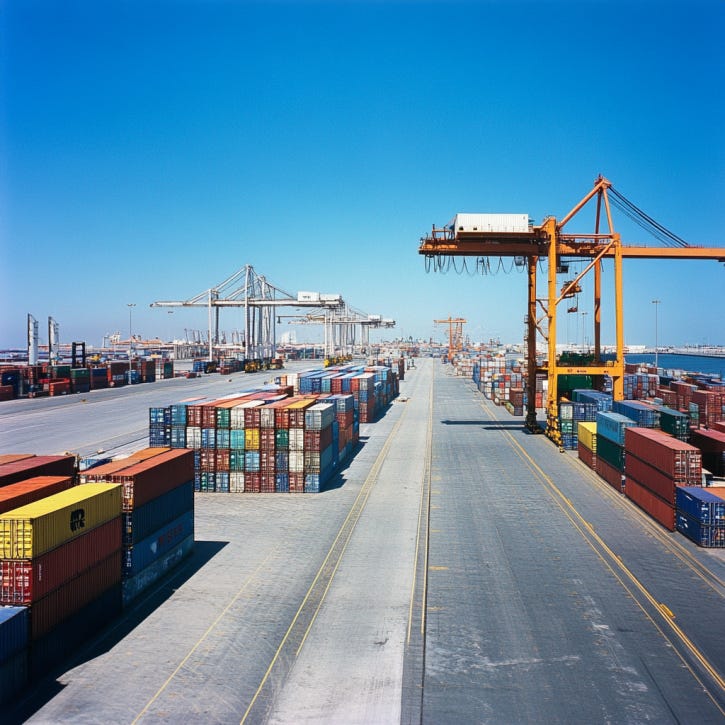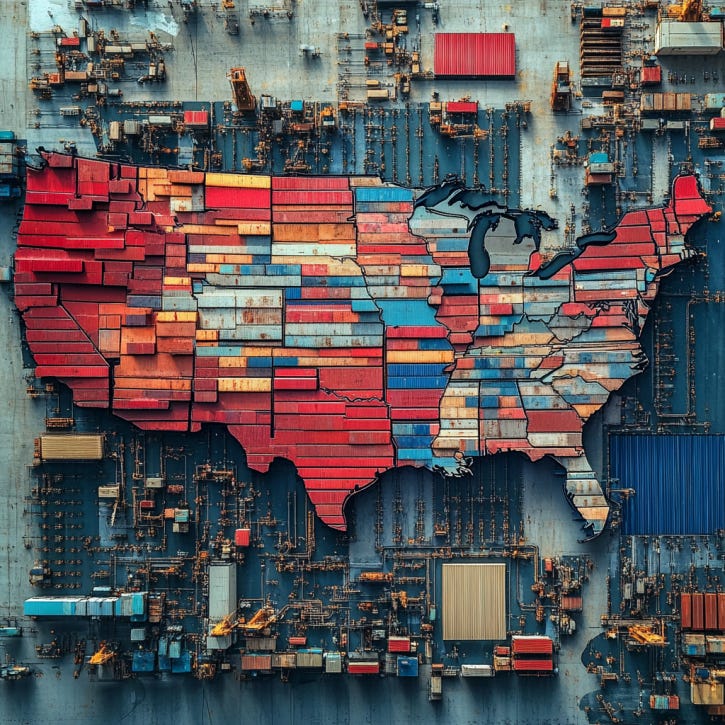The U.S. Needs to Automate All Ports & End the ILA Strike via Buyouts: A ~$100B Solution
Not automating the ports is like banning uber to protect cab drivers...
ht in 2024 when he initiated an ILA (International Longshoremen’s Association) strike in October, marking the first East Coast port strike since 1977… the ILA demanded a pay raise and to freeze automation at East Coast and Gulf Coast ports.
Longshoremen were earning $39/hr at the time… under Daggett’s proposal the top wage would get bumped to $69/hr with a ~60% increase in pay over 6 years.
Daggett & the ILA issued a video stating:
“When my men hit the streets from Maine to Texas, every single port locked down. You know what’s going to happen? I’ll tell you. First week, I will be all over the news every night, boom, boom, second week. Guys who sell cars can’t sell cars, because the cars ain’t coming in off the ships. They get laid off. Third week, malls are closing down. They can’t get the goods from China. They can’t sell clothes. They can’t do this. I deserve more money. Everything in the United States comes on a ship, they go out of business. Construction workers get laid off because the materials aren’t coming in. The steel’s not coming in. The lumber’s not coming in. They lose their job. Everybody’s hating my guys now because now they realize how important our jobs are.”
Daggett understands the magnitude of his power and that he can hold the U.S. hostage because they are generally too soft (unlikely to do anything) and are afraid of buying out workers for some reason.
This strike was suspended on October 3, 2024 after a tentative agreement was reached “on wages” extending the Master Contract until January 15, 2025 to return to the bargaining table to negotiate all other outstanding issues.
The 2024-2025 Port Strike & Anti-Automation Stance
Parties Involved
International Longshoremen’s Association (ILA): ~45,000 dockworkers across U.S. East and Gulf Coast ports.
U.S. Maritime Alliance (USMX): Represents port operators and shipping companies.
Core Issues
Automation: The ILA strongly opposes introducing semi-automated cranes and advanced robotics, arguing that these technologies threaten jobs and do not necessarily boost efficiency.
Wages: A tentative agreement in October 2024 offered a 62% wage increase over six years (raising top hourly pay from $39/hour to $60+/hour). The union hasn’t ratified it because automation remains unresolved.
Why the ILA Refuses Automation
Job Security / Higher Pay for Fewer Hours
Dockworkers can earn $200,000+ annually with overtime and container royalties.
Full automation would likely reduce overtime, undermining a major income source.
As long as cargo flows remain high and terminals remain largely manual, the ILA can “milk the system,” maintaining strong wage/benefit packages.
Union Leverage and Royalties
Some East Coast contracts include container royalty payments, effectively a fee per container.
Automating cargo handling could reduce container throughput’s required labor, undercutting the union’s bargaining power to demand or preserve those royalties.
Cultural and Political Support
President-elect Donald Trump has openly supported the union’s anti-automation stance, emboldening the ILA to resist modernization.
Political figures often align with labor demands to gain electoral favor, reinforcing union leverage.
Lack of Immediate Proof of Efficiency Gains
Certain studies (e.g., a 2023 Barcelona-based report) argue that automation doesn’t always guarantee drastically faster turnarounds.
The union cites such research to question whether the ROI for automation is as large as port operators claim.
How Do the U.S. Striking Ports Rank Globally?
The striking ports are collectively on the U.S. East and Gulf Coasts—covering about 36 ports from Maine to Texas, including major gateways like:
Port of New York & New Jersey
Port of Savannah
Port of Houston
Port of Charleston
Port of Virginia (Norfolk)
Port of Miami
Port of Jacksonville
Port of Baltimore
Port of Philadelphia
Many of these, when individually ranked, do not appear in the top 20 or top 50 of the 2023 Container Port Performance Index (CPPI).
Below are some highlights based on the CPPI 2023 aggregated list (using the ranking methodology from the World Bank–S&P Global Market Intelligence study):
Port of Charleston: CPPI 2023 places Charleston around #53 out of 405 global ports.
Port of Philadelphia: ~#55
Port of Norfolk (Virginia): ~#301 in the “administrative approach” ranking (lower in the statistical approach).
Port of New York & New Jersey: ~#92 to #99, depending on approach.
Miami: ~#74 to #77.
Houston: ~#312 to #338.
Other East/Gulf Coast ports (e.g., Savannah, Jacksonville) either rank in the 80–150 range or often don’t appear high in either the “administrative” or “statistical” approach.
None are close to the CPPI’s top 20. They consistently lag behind leading ports like Yangshan, Salalah, Cartagena, Tanjung Pelepas (all top 10–15). Even some mid-tier Asian and European ports outrank them.
Overall: Striking U.S. East/Gulf Coast ports are generally in the middle or lower half of the global rankings, nowhere near the best-performing ports worldwide.
Financial & Productivity Losses: The Longer the Strike Drags Out
Short-Term Economic Disruption
Cost per Day
Potential $500 million to $5 billion daily impact if a port shutdown or severe slowdown occurs.
Many estimates land around $3–$4 billion in daily losses. A one-week strike could shave ~0.1% off U.S. GDP, or $3.8–$4.0 billion in direct economic damage.
Ripple Effect on Supply Chains
Each day of strike can create 3–5 days of backlog recovery. An 11-day shutdown in 2002 took 6 months to fully unwind.
Key sectors hit: Retail, automotive, agribusiness, electronics, fresh produce—where shipping costs would spike from rerouting or forced air freight.
Added Surcharges and Inefficiencies
Lines like Hapag-Lloyd already impose “work disruption surcharges” ($850–$1,700/container), costs ultimately borne by importers and consumers.
Long-Term Drag on Competitiveness
Eroded Global Confidence
Chronic labor unrest + subpar efficiency can push foreign buyers to shift supply chains to ports outside the U.S.
Large carriers may consolidate calls at West Coast or Canadian ports—or even in Mexico—if East/Gulf Coast ports remain unpredictable.
Permanent Loss of Market Share
Once shippers invest in alternative routes, they often don’t revert just because the strike ends.
Ports like New York–New Jersey risk losing cargo to Halifax or Montreal (Canada), or other East Coast transshipment hubs.
ILA Negotiations: Eternally Milking the System
Some analysts argue the ILA union benefits from prolonging negotiations and striking periodically.
Periodic Wage Hikes: Every bargaining cycle yields higher base pay, overtime rates, container royalties—without guaranteeing parallel productivity improvements.
Political Leverage: Politicians—Donald Trump, in this context—pledge support to keep union labor happy, providing further cover to reject automation proposals.
No Immediate Productivity Tie: The union’s wages aren’t strictly tied to throughput metrics, so there’s no direct penalty for slower container handling. Shippers, importers, and end consumers shoulder inefficiency costs via higher fees or shipping delays.
Fear Tactics: Threatening to shut ports that handle 50–60% of America’s container cargo is an immense bargaining chip. The ILA can threaten massive economic disruption to “milk” more concessions from USMX each contract cycle.
Why U.S. Ports Lag Globally in Rankings…
Dominance of Asian and Middle Eastern Ports: Yangshan (China) #1, Salalah (Oman) #2, Tanjung Pelepas (Malaysia) #5. These ports boast extensive automation, advanced terminal operating systems (TOS), 24/7 operations, and sophisticated connectivity to hinterlands.
Limited Automation
Fewer than 5% of U.S. terminals (roughly 4 out of 360) have semi-automated systems.
The U.S. heavily relies on manual labor for container handling, equipment operation, and gate procedures.
Labor-Intensive Operations
High reliance on manual yard moves slows turnaround times and raises operational costs.
Overtime pay structures incentivize extended shifts rather than process improvements.
Restricted Operating Hours
Unlike major hubs in Asia and the Middle East that operate continuously, many U.S. terminals close for nights, weekends, or shift changes.
This reduces effective throughput and forces carriers to plan around limited gate hours.
Fragmented Infrastructure
Ports face political and regulatory constraints (state/local vs. federal jurisdictions), complicating major capital projects.
Frequent design changes, funding challenges, and local stakeholder pushback slow modernization efforts.
Why the U.S. Needs to Automate Its Ports Rapidly
Automating the U.S. ports is a “no-brainer” move… and should’ve been done years ago. Since we didn’t automate yesterday, the next best time to automate is now.
Global Competitiveness & Supply Chain Reliability: Automation cuts vessel berthing time, reduces waiting hours, stabilizes schedules. Ship lines prefer ports that rapidly turn ships around—directly boosting competitiveness.
Operating Cost Savings: Studies show 25–55% reduction in terminal operating expenses with advanced automation. Even a conservative 30% expense cut is enormous for a major container gateway.
Throughput & Capacity Gains: Automated cranes can significantly boost container moves/hour, vital for mega-vessels (15k–24k TEUs). Yangshan in China handles 40+ crane moves/hour in fully automated sections; U.S. ports often struggle at 25–30.
24/7 Operations without Overtime Penalties: Robots don’t require overtime, breaks, or shift differentials. For large volumes, round-the-clock automation provides predictable, stable costs.
Reduced Injury & Liability Risks: Remote crane ops, driverless vehicles lower workplace accidents, insurance, and litigation overhead.
Environmental & Fuel Savings: Automated ports rely on electric or hybrid systems optimized by software, cutting emissions and fuel usage.
Financial Gain Estimates
Implementation Cost per Terminal: $500 million–$1 billion for a full retrofit.
Annual Savings per Terminal: 25–35% OPEX reduction ($50–$100 million for a high-volume facility).
Payback: 6–15 years, depending on throughput and initial capex.
Nationwide Scope: If 30–40 major terminals automate, $2–$3+ billion annually in industry-wide savings. Plus intangible benefits: fewer surcharges, better schedule integrity, stronger capacity for future demand.
What If the U.S. Fails to Automate? (Negative Implications)
Below is an illustrative “non-automation penalty”:
Excess Labor Costs & Congestion: An estimated $100–$150 million per year in extra labor and congestion costs per large terminal. Over a decade, for roughly 15 key East/Gulf Coast terminals, that balloon can reach $15–$22.5 billion.
Periodic Strikes: Every 6 or so years, a major strike or near-strike can cost $3–$5 billion (direct + indirect). Over 10–15 years, multiple disruptions may total another $10–$15 billion.
Lost Cargo Volume: Losing just 5–10% of discretionary cargo to Canada, Mexico, or other routes can represent $20–$30 billion in foregone economic throughput over a decade.
Summing these rough estimates, the U.S. could face $45–$67+ billion in extra costs, inefficiencies, and lost business opportunities within 10–15 years if automation remains stalled.
Estimated Buyout of Longshoremen: ~$100B (2025)
Rough Calculation
East Coast (~25,000 ILA workers)
Average total compensation: ~$150,000/year (base $39/hr + overtime + benefits).
10-year buyout: $150k x 25k x 10 = $37.5 billion.
West Coast (~16,400 ILWU workers)
Average comp: ~$233,000/year.
10-year buyout: $233k x 16,400 x 10 = $38.2 billion.
Combined: Over $75+ billion in a decade if both coasts are fully bought out, plus the separate automation costs.
Automation Infrastructure Costs
$500M–$1B per major terminal for advanced automation.
For ~30 high-volume terminals, total capital easily $15–$30+ billion, plus integration/training.
Grand Total: $100+ billion (buyouts + infrastructure) over 5–10 years—enormous, yet spread across decades of subsequent savings, speed, and global competitiveness gains.
When the U.S. Would Start Saving Money (Post- Buyout & Automation): A Timeline to Profitability
Timeline to Net Gains
Years 1–3: Large capital outlays. Productivity may dip 7–15% as new systems phase in. Possible lumpsum workforce buyouts if enacted.
Years 3–6: Processes stabilize. Overtime labor shrinks. Operators see 25–35% cost reductions. Terminals become more attractive for bigger container vessels.
Year 7 Onward: 24/7 high-efficiency ports. Ship lines trust schedules, capacity grows with fewer labor constraints. Some terminals realize net positive ROI each year beyond year 7.
Potential High-Level Figures
Annual Savings per Terminal: $50–$100 million.
National Aggregate: $2–$3 billion+ across ~30 large terminals.
Macroeconomic Multiplier: Lower shipping costs → improved consumer spending, more stable supply chains, higher import/export volumes.
Resisting Port Automation is Like Banning Uber to Protect Taxi Unions
I thought it would be useful to illustrate how retarded it is to resist port automation in the U.S. Below are some analogies I came up with… I had ChatGPT add a few more… they aren’t 1:1 perfect analogies but should help you get the point.
Banning Uber to Protect Taxi Drivers: Uber offered a disruptive, more efficient model—taxis lost revenue. Similarly, automation disrupts manual dock labor. Consumers (shippers/importers) bear higher costs and less convenience when innovation is blocked.
Banning Cars to Protect Horse-and-Buggy Drivers: A foundational shift from manual to machine labor—once the shift happens, there’s no turning back. Clinging to old methods isolates an industry and destroys competitiveness.
Banning Calculators to Protect People Who Do Math by Hand: Automation, like a calculator, speeds routine tasks. Fears of job displacement echo the concerns that “machines will replace math teachers.” In practice, humans shift to higher-level tasks.
Banning ATMs to Protect Bank Tellers: ATMs automate routine deposits/withdrawals, freeing staff for more complex tasks. Dockworkers could move into supervision, tech maintenance, or advanced logistics roles.
Banning E-Commerce to Protect Brick-and-Mortar Retail: Online retail was disruptive but ultimately beneficial to consumers. Ports that never embrace automation risk losing “customers” (shippers) to more modern, nimble global gateways.
Banning Generative AI to Protect Writers and Journalists: AI-driven content creation spurs fear of job loss, similar to crane automation displacing manual cargo handling. Both scenarios highlight how refusing technology stifles productivity gains and competitiveness.
Banning Word Processors to Keep Typists Employed: Word processors drastically improved editing/formatting. Typists initially feared it. Ports, similarly, face union fears that machines will replace manual labor, ignoring the possibility of upskilling or new roles.
Banning Electric Vehicles to Protect Gas-Powered Car Manufacturers: EVs threaten entrenched ICE manufacturing jobs. Ports refusing automation are likewise resisting advanced tech, risking obsolescence in the face of global green/modern standards.
Banning Streaming Services to Protect Cable TV: Streaming disrupted cable. Cable companies that didn’t adapt saw massive subscriber losses. Ports not automating risk losing shipping routes to more efficient terminals.
Banning Online Education to Protect Traditional Schools: Online learning upends conventional classrooms. Ports refusing automation parallel schools that refuse digital methods—limiting reach, scalability, and efficiency.
Each scenario shows disruptive innovation that threatened older industries. In nearly all cases, protecting the legacy model:
Raises costs,
Lowers competitiveness,
Hurts consumer outcomes.
That’s exactly the risk if U.S. ports reject automation.
Final Take: The Case for Swift, Comprehensive Automation
Although the cost of buying out tens of thousands of longshoremen plus automating terminals can exceed $100 billion, the mid- and long-term gains—billions in annual savings, faster throughput, and stable supply chains—make it the most logical thing to do.
Status Quo = Repeated Strikes and High Costs: The ILA’s strong anti-automation stance keeps modernization at bay. Demand for labor remains high, wages/benefits keep climbing. Port competitiveness suffers.
Massive Hidden Costs of Delay: $3–$5 billion in daily indirect/direct losses from strikes or slowdowns. Repetitive negotiations feed a cycle of union leverage, pushing wage demands further.
Clear Financial Upside to Automation: Upfront $100+ billion in buyouts + infrastructure seems staggering but yields decades of lower operating expenses, stable labor environment, and improved capacity.
Full Buyout: Politically Painful, Perhaps Inevitable: A 10-year buyout of East/West coast labor runs $70–$80+ billion. This ends the recurring friction, ensuring 24/7 fully automated operations and minimal strike risk.
National Competitiveness at Stake: The U.S. lags ports like Yangshan, Rotterdam, Singapore—modern, automated, and faster. Without bold moves, cargo diversions to Canada or Mexico become more frequent. Adopting automation cements the U.S. as a top-tier global maritime hub, attracting more shipping lines and sustaining economic growth.
The alternative? Ongoing union standoffs, repeated wage hikes, subpar efficiency. This locks America into second-rate port rankings and surrenders significant economic potential. By acting decisively, the U.S. can transform its ports into world leaders and ensure national competitiveness for the next half-century.
A Plan to “Make U.S. Ports Great Again” (MUPGA)
Below is a strategic plan to tackle the port automation standoff and position the U.S. for global maritime dominance in both the short and long term.
This approach focuses on three core pillars: forceful federal intervention, a strategic buyout/redeployment framework for dockworkers, and an accelerated automation ramp-up.
It aims to overcome union resistance and rapidly modernize U.S. ports… some may perceive it as a bit cutthroat, but it’s what should’ve already been done.
A.) Federal Intervention, Authority, Timeline
Declare Automation a National Priority
Justify using national security and economic grounds (similar to how port operations are critical infrastructure).
Formally place the modernization of U.S. ports under a “National Maritime Innovation Mandate,” signed as an executive action.
Set Hard Deadlines
Mandate that all major container terminals handling over 1 million TEUs/yr implement semi-automation (or higher) within 3 years.
For mid-sized terminals (0.5–1.0 million TEUs/yr), require a 5-year schedule to adopt partial automation.
Enforce penalties and withhold federal infrastructure grants from ports that miss these deadlines.
Override Collective Bargaining Impasses
If necessary, invoke the Taft-Hartley Act or similar legal measures to preemptively halt or end any strike that blocks critical port functions.
Expedite legal authority (via executive order or legislation) to limit unions’ ability to collectively bargain the fundamentals of automation—only leaving room to negotiate the terms of any buyout or retraining.
B.) Strategic Buyout & Workforce Redeployment
One-Time “Super Severance” Buyout
Offer each longshoreman a buyout package equivalent to 5–10 years of total compensation (including overtime averages).
Structure it as a lump-sum or phased payout over 2–3 years to avoid immediate budget shocks.
Tie the buyout to a legal relinquishment of longshoremen job rights in those automated terminals.
Alternative Job Pathways
Create advanced port-technology training programs for younger or tech-savvy workers who wish to remain.
Positions could include software/hardware maintenance, crane programming, robotic yard vehicle oversight.
The federal government partially subsidizes these upskilling efforts, ensuring enough specialized labor remains to supervise automated systems.
Union-Diluted Labor Model
Offer any remaining labor (e.g., for non-automatable tasks) the ability to remain unionized but with drastically fewer headcount requirements.
Freeze further union expansion or new membership in container-handling roles—phasing down workforce over 10 years.
Financial Logistics
Estimated cost: $75–$80 billion for buyout nationwide (East, Gulf, and eventually West Coast).
Combine direct federal funds (partial) + port authority bonds + operator-level financing (via consortium of shipping lines & terminal operators).
Condition federal funds on explicit adoption of advanced port systems within the mandated timetable.
C.) Accelerated Automation Ramp-Up
Standardize Best-In-Class Technologies
Mandate that large terminals adopt proven automation systems (e.g., remote-controlled ship-to-shore cranes, Automated Guided Vehicles, yard-automation software).
Leverage proven designs from high-efficiency ports (Yangshan, Rotterdam, Singapore) to minimize deployment risk and speed up rollout.
National “Port Tech Standards” Board reviews vendor solutions and sets interoperability protocols.
Infrastructure Fast-Track
Expand capital expenditures for dredging deeper berths, building on-dock rail, and broadening yard footprints to accommodate next-gen equipment.
Prioritize sites with the highest ROI: e.g., ports that already handle millions of TEUs and can yield the most cost savings once automated.
24/7 Operations Mandate
Institute around-the-clock port operations with fixed (non-labor-inflated) scheduling of automated machinery.
Eliminate overtime premiums for automated equipment operation, ensuring cost stability.
Cross-Port Data Integration
Create a nationwide port data exchange, allowing carriers, truckers, and rail to share real-time cargo visibility—made easier by uniform automated systems.
A central “Port Performance Dashboard” helps identify choke points immediately, helping the supply chain run more smoothly and efficiently.
D.) Short-Term Stability Measures (Next 1–3 Years)
Deploy Federal Port Mediation Teams
Station them at all major East/Gulf Coast terminals to handle labor blowback in real-time.
These teams enforce the strike ban (if invoked) and expedite negotiations around severance details, retraining, and transitional logistics.
Incentivize Early Adopters
Ports that begin partial automation ahead of schedule receive bonus grants or low-interest loans for equipment purchase.
Offer cargo discounts or lower port fees to shipping lines that berth at automated terminals (to accelerate traffic flows and encourage other terminals to catch up).
Temporary Skilled Labor Pool
During the transitional period (while buyouts and retraining happen), maintain a transitional pool of specialized workers or contractors to keep cargo moving consistently.
This protects supply chains from near-term disruptions.
E.) Long-Term Dominance Strategy (3–10+ Years)
Global Cargo Hub Vision
Position at least 2–3 major East/Gulf Coast ports to become transshipment mega-hubs, competing with global leaders.
Combine automation with foreign trade zones, advanced logistics parks, and integrated rail corridors.
Relentless Efficiency Audits
Mandate annual productivity benchmarks across all automated terminals—publicly release each port’s metrics (moves per hour, vessel turnaround time).
Tie further federal infrastructure money to continuous improvement, ensuring that any stagnation is corrected swiftly.
Driving Next-Gen Innovations
Experiment with autonomous container barges between smaller regional ports, AI-based yard planning, and real-time dynamic crane scheduling.
Scale up pilot programs for hydrogen or electric-powered container movers to reduce emissions.
Contract Lock-Ins
Guarantee shipping lines and major beneficial cargo owners (e.g., Walmart, Amazon) stable multi-year contracts with fully automated U.S. ports—further reducing the likelihood they divert to Canada or Mexico.
F.) Financial & Economic Rationale: The Bottom Line
Cost of Inaction
Strikes every few years, billions in lost trade, eroded competitiveness vs. Asian/European hubs.
Additional hidden cost: lost investor confidence in the U.S. supply chain (drives companies to set up in more reliable global regions).
Project Cost vs. ROI
Buyout: $75–$80 billion
Terminal Automation: $30–$50 billion
Total: $105–$130 billion (over perhaps a decade)
Annual Savings: Potentially $10–$15+ billion in operating cost reductions, reduced congestion, faster vessel turnaround, plus intangible benefits of supply chain stability and additional cargo throughput.
Job & Economic Growth
Although direct longshoremen roles shrink, thousands of higher-tech port jobs in robotics, software, and systems oversight emerge.
More efficient ports spur manufacturing, assembly, and distribution expansions near the coasts, creating tens of thousands of ancillary jobs.
Final Port Strategy (Overview)
This plan is aggressive but is the only way to ensure the U.S. does not keep hemorrhaging economic advantage to more modernized ports worldwide.
Strike Force: Immediately block or end any strike attempts via federal injunction, and legally secure the right to implement automation.
Buy Them Out: Offer a massive but finite buyout to union workers, removing future bargaining blockades.
Enforce Automation: Impose tight deadlines, with penalties for non-compliance, ensuring all major terminals become automated.
Reap the Gains: Achieve fast vessel turnarounds, cost savings in the tens of billions, and secure a globally competitive maritime infrastructure for decades to come.
By coupling decisive federal leadership, a robust buyout program, and mandatory port automation timetables, the U.S. can vault itself to top-tier maritime status and end the cycle of labor strife that has plagued its container gateways.


